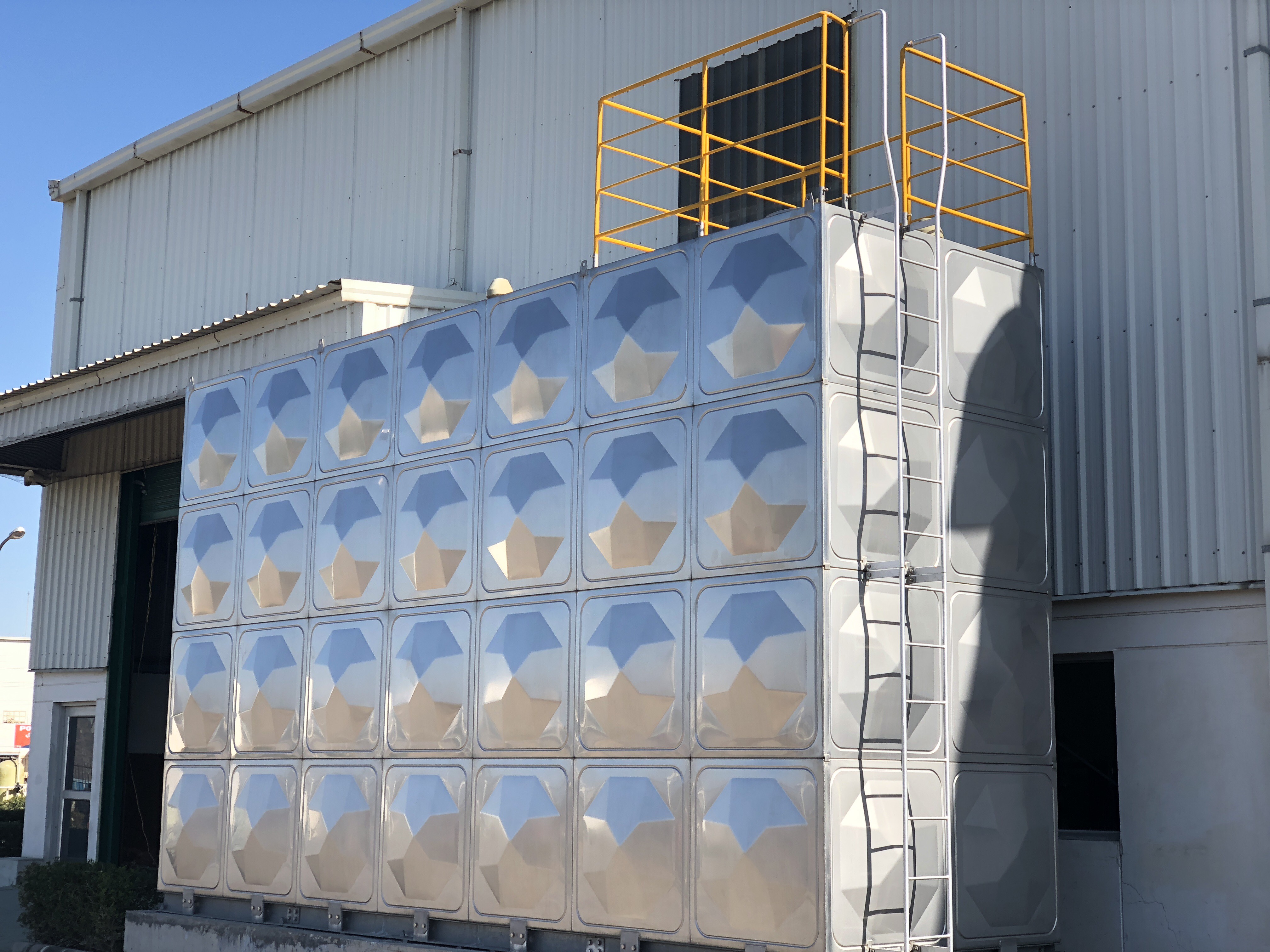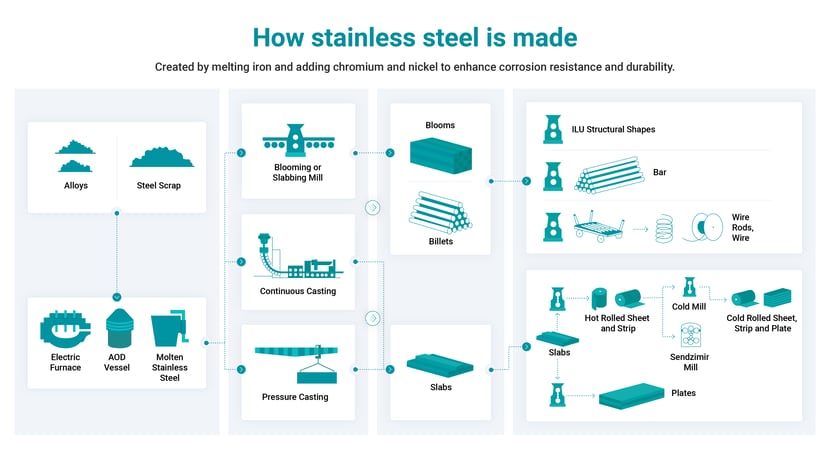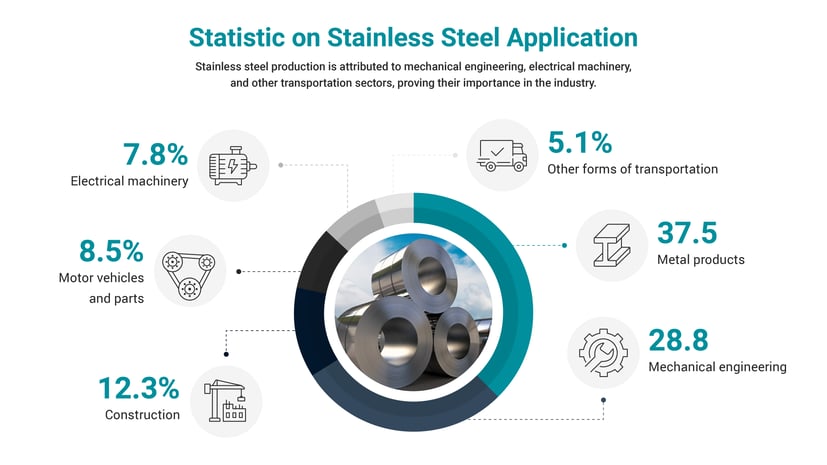Stainless Steel Tanks: Trends, Manufacturing, and Benefits in India

Are you familiar with stainless steel tanks?
You must have as they are used in various industries, from manufacturing to pharmaceuticals, and even in food processing.
What's even more impressive is that the global stainless steel market is rapidly expanding, boasting an annual CAGR of 4.6% annually from 2021 to 2026.
That's huge indeed!
But why are stainless steel tanks so popular?
Well, it's because they are incredibly robust, resistant to corrosion, and ideal for storing liquids and other materials. These qualities set stainless steel tanks apart.
Now you must be curious to learn more about stainless steel in depth and how it's crafted, right?
You're not alone.
That's why in this blog we will give you all the answers you seek. We'll start by explaining what stainless steel is and how it's manufactured. Then, we'll dive into its wide-ranging applications, the latest trends, and the numerous advantages it offers across different industries.
So, without further ado, let’s get started.
|
What is Stainless Steel?
Stainless steel is a type of steel alloy that contains a significant amount of chromium. This means that it doesn't easily stain, rust, or corrode. That’s where it got its name – stainless.
But how does this happen?
It happens because of the formation of a thin, protective oxide layer on the steel's surface when exposed to oxygen. Not just that. Stainless steel alloys also typically contain other elements like nickel and molybdenum to increase their corrosion resistance and durability.
Now that you know what stainless steel is. Let’s explore how it is made.
The Entire Process of Making Stainless Steel

The above image is a re-creation of the ssina.com
To make the stainless steel follow the following steps:
Step 1: Gather Raw Materials
The process of stainless steel making starts with collecting iron ore, which is the primary raw material. You should also gather other elements like chromium, nickel, and sometimes molybdenum.
Step 2: Smelt Iron Ore
Melt the collected iron ore in a blast furnace. This super-hot furnace heats the ore until it turns into molten iron.
Step 3: Mix with Other Elements
After smelting iron ore, you have to add and mix other elements like chromium and nickel to it. These are called alloying elements because they give stainless steel its unique properties.
Step 4: Remove Impurities
You should remove any impurities or unwanted elements from the mixture to make sure the stainless steel is pure and strong.
Step 5: Cooling and Forming
After mixing and purifying, cool down the molten metal and shape it into multiple forms like sheets, bars, or coils.
Step 6: Heat Treatment Process
In this step, give a heat treatment process to your stainless steel so that it becomes even stronger. This process is like giving the steel a final boost to be better at resisting things like rust.
Step 7: Cutting and Shaping
Now that the stainless steel is almost ready, cut it and give a shape to the final products you or your customers use, like water tanks for industrial and commercial purposes, sheets for kitchen appliances, and pipes for construction.
This is how the stainless steel gets ready that you encounter in your everyday items like water tanks, kitchen appliances, etc.
6 Key Trends of Stainless Steel Tanks in India
India's industrial landscape is evolving at a rapid pace, and stainless steel tanks are at the forefront of this transformation. Understanding the current trends in their adoption is crucial to stay ahead in stainless steel solutions. And, here are the 6 key trends shaping the stainless steel tank industry in India:
Trend #1: Water Storage Solutions
In India, the increasing need for reliable water storage solutions is driving a rising trend in the use of stainless steel tanks. With water scarcity concerns in various regions, stainless steel tanks offer a durable and hygienic option for water storage for homes, industries, or agriculture.
Trend #2: Sustainable Practices
As sustainability gains importance globally, India is no exception. Stainless steel tanks align with this trend as they are eco-friendly and recyclable. Industries and individuals are opting for stainless steel tanks to reduce their environmental impact and promote sustainability.
Trend #3: Food Processing
The food processing industry in India is booming, and stainless steel tanks are a crucial part of this trend. They use these tanks for storing and processing food products, ensuring hygiene and quality. The food industry's focus on quality and safety has led to increased demand for stainless steel tanks.
Trend #4: Pharmaceutical and Healthcare
Stainless steel tanks are becoming increasingly popular in the pharmaceutical and healthcare industry as well. With a growing pharmaceutical industry in India, these tanks meet the stringent requirements for storing and processing drugs and other healthcare products.
Trend #5: Industrial Applications
Various industries, including chemicals, petrochemicals, and manufacturing, are witnessing a surge in the use of stainless steel tanks. This trend attributes itself to the tanks' corrosion resistance, durability, and compliance with safety standards.
Trend #6: Customisation
Everyone needs customization nowadays and it's on the rise in India. You can tailor stainless steel tanks as per your specific needs – making it important for industries that require unique tank designs and sizes to meet their processes' demands.
These trends highlight the growing significance of stainless steel tanks in India. As industries and individuals in India embrace these trends, stainless steel tanks continue to play a crucial role in supporting various sectors' growth and development.
Now let’s explore the applications of stainless steel tanks.
Stainless Steel Applications
The above image is a re-creation of the original image.
According to Statista Research, 41.8% of the stainless steel produced worldwide is used by mechanical engineering, electrical machinery, and other transport industries.
As you can see the usage of this steel as per the statistic. It is no wonder that stainless steel tanks are the unsung heroes. It seamlessly adapts to the unique demands of industrial, commercial, and domestic sectors across India.
Here's how it serves distinct purposes in each of these domains:
1. Stainless Steel in Industrial Use
Here are the uses of this steel in the following 3 industries:
-
Chemical Industry
Stainless steel tanks form the backbone of the chemical industry, securely storing and processing an array of chemicals. Their robust corrosion resistance ensures both product safety and industry compliance. -
Petrochemical Industry:
In the petrochemical sector, these steel tanks store petroleum products safely and securely, preserving the integrity of fuels and chemicals. -
Pharmaceutical Industry:
For the pharmaceutical sector, stainless steel tanks are essential for the safe storage and processing of drugs and healthcare products. Their hygienic properties are non-negotiable in ensuring product purity.
2. Commercial Applications
Here are the uses of this steel in the following ways:
-
Food and Beverage
Stainless steel tanks are the lifeblood of the food and beverage industry. They are deployed for everything from ingredient storage to fermentation, contributing to food safety and quality. -
Hospitality
In the hospitality sector, stainless steel tanks are found in commercial kitchens and bars, enhancing food preparation and beverage storage. Their durability and easy-to-maintain surfaces are vital for the hospitality business. -
High Rise Commercial Building
Due to high rise building, lightest water storage solution is admired by the designer/developer so stainless steel water tanks become the best choice where Beltecno is well known for its ligest water storage tank solution.
3. Domestic Utility
Here are the uses of domestic applications of this robust steel:
-
Water Storage
In Indian households, stainless steel tanks play a pivotal role in water storage. Their corrosion resistance and ease of cleaning ensure the provision of safe and clean drinking water. -
Kitchen Appliances
Stainless steel tanks are a common feature in kitchen appliances like refrigerators and water heaters, contributing to the longevity and hygiene of these essential home devices.
From sustaining industrial processes to facilitating commercial activities and enhancing domestic life, stainless steel tanks show their versatility, reliability, and adaptability across a wide spectrum of Indian applications.
But that's not all.
It offers more benefits so let’s find it out here by continuing reading.
Benefits of Using Stainless Steel Tanks
Stainless steel water tanks offer many advantages, including
- One of the standout advantages of stainless steel is its exceptional corrosion resistance. This feature ensures that the water stored within remains free from rust and contaminants, maintaining water quality consistently throughout manufacturing processes.
- Manufacturing industries often demand stringent hygiene standards. Stainless steel tanks meet these requirements with ease. Their easy-to-clean and smooth surfaces prevent bacterial growth and the accumulation of impurities, guaranteeing the purity and safety of the water used in manufacturing processes.
- Stainless steel tanks are built to last, even in demanding industrial environments. Their high resistance to wear and tear reduces maintenance costs, extending the tank's lifespan and ensuring a cost-effective, long-term solution for water storage.
- The adaptability of stainless steel tanks is crucial in manufacturing. These tanks can be customized to fit specific processes and space constraints, optimizing their integration into the manufacturing facility.
- Stainless steel tanks are renowned for complying with strict regulatory and quality standards, ensuring that the stored water meets all quality requirements.
- Sustainability is an essential consideration in modern manufacturing. Stainless steel is an environmentally friendly material that can be recycled, reducing its environmental impact. Its long lifespan aligns with sustainability efforts by decreasing the need for frequent replacements.
- Stainless steel tanks can handle a wide range of temperatures, making them suitable for diverse manufacturing processes that involve hot or cold water storage.
- In manufacturing environments, where hygiene and cleanliness are paramount, the polished and aesthetically pleasing appearance of stainless steel tanks is not just about looks. It also contributes to maintaining a clean and professional appearance, which can be vital in certain manufacturing settings.
These benefits collectively make stainless steel water tanks an invaluable asset, supporting operations with efficiency, quality, and compliance.
But do you know there are two essential features that you must check in while taking stainless steel water tanks?
If not, then let’s jump into it right away.
2 Essential Features of Stainless Steel Water Tanks
There are two most important features that make stainless steel tanks stand out:
-
Weight of the tank
Ensure that your tank is not heavier because stainless steel tanks are incredibly lightweight. They weigh only about 1/30th of concrete tanks. This means they're much easier to move and install. Imagine lifting something that's 30 times lighter – it makes the whole process simpler and more efficient.
-
Installation Time
Make sure that while you’re installing the water tank, it doesn’t take more time than required. Installing stainless steel tanks is super quick when you’re doing it with Beltecno. It takes just 1/3 of the time needed for concrete tanks. This speedy installation not only saves your time but also minimizes interruptions to ongoing work. For industries with busy schedules, this fast and efficient process is a game-changer.
These special features are what set stainless steel tanks apart, making them a smart choice for various applications where fast installation, ease of handling, and a lightweight design are essential. Beltecno's stainless steel tanks harness these advantages to provide efficient and reliable solutions for a wide range of industries.
Wrapping Up
Now that you understand the significance of stainless steel tanks, it's clear they serve multiple purposes – meeting our water storage needs, promoting eco-friendliness, and maintaining high quality. In this context, one of the top manufacturers in the stainless steel industry is Beltecno.
They offer a range of products including stainless steel water tanks, panel tanks, storage tanks, and plate heat exchangers. What's more, they are in perfect sync with India's journey towards cleanliness, adaptability, staying up-to-date with trends, and embracing eco-friendliness.
So, if you're looking for firsthand experience in leveraging the perks of stainless steel tanks, consider Beltecno. They are not only reliable but also offer great quality products with state of art manufacturing facilities and highly skilled technicians by Japanese experts, and a future that's greener and more efficient.
